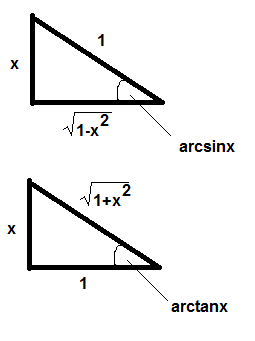How do you solve #sin^-1(x)+tan^-1(x)= pi/2#?
2 Answers
Despite that this form is comparable with the formula
Explanation:
Despite that the form is comparable with the general formula
I got
First, let's see how many solutions this has by taking the derivative.
#= 1/(sqrt(1-x^2)) + 1/(1+x^2)#
Since neither term can be negative, we have no minimum or maximum, and thus, we have either one or zero solutions to this equation. This is also shown from the graph of
graph{arcsinx + arctanx - pi/2 [-6.18, 7.87, -5.077, 1.95]}
Here's something interesting we can try...
#cos(arcsinx + arctanx) = cos(pi/2) = 0#
Now, recall the additive angle formula for
#cos(u + v) = cosucosv - sinusinv#
Since
#cos(arcsinx + arctanx)#
#= cos(arcsinx)cos(arctanx) - sin(arcsinx)sin(arctanx)#
#= color(red)(cos(arcsinx)cos(arctanx) - xsin(arctanx))#
This should be handled with a triangle depiction now... Since
Thus:
#cos(arcsinx) = sqrt(1-x^2)# #cos(arctanx) = 1/sqrt(1+x^2)# #sin(arctanx) = x/(sqrt(1+x^2))#
Note that for each of these, since we started from positive
#sqrt(1-x^2)/(sqrt(1+x^2)) - x^2/(sqrt(1+x^2)) = 0#
#(sqrt(1-x^2) - x^2)/(sqrt(1+x^2)) = 0#
#sqrt(1-x^2) - x^2 = 0#
#sqrt(1-x^2) = x^2#
#1-x^2 = x^4#
#x^4 + x^2 - 1 = 0 | x in [0,oo)#
Then, we can complete the square for this quartic equation to simplify it:
#x^4 + x^2 = 1#
#x^4 + x^2 + (1/2)^2 = 1 + (1/2)^2#
#x^4 + x^2 + 1/4 = 5/4#
#color(green)((x^2 + 1/2)^2 = 5/4 | x in [0,oo))#
Finally, solve for
#x^2 + 1/2 = sqrt(5)/2#
#x^2 = sqrt(5)/2 - 1/2#
#color(blue)(x = sqrt(sqrt(5)/2 - 1/2) ~~ 0.786)#
Indeed, Wolfram Alpha gets the same thing.
And the graph of


